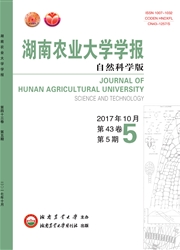

 中文摘要:
中文摘要:
以湘杂油763为材料,研究了施肥水平(以N、P2O5、K2O、B计,处理A分别为240、120、210、1.2kg/hm^2;处理B分别为180、90、157.5、0.9kg/hm^2;处理C分别为120、60、105、0.6kg/hm^2;处理D分别为60、30、52.5、0.3kg/hm^2;处理E为不施肥)和种植密度(7.5×10^4、1.5×10^5、2.25×10^5、3.0×10^5、3.75×10^5、4.5×10^5株/hm^2)对油菜籽粒油分、蛋白质、硫苷和芥酸含量的影响。结果表明:籽粒油分含量和蛋白质含量受施肥量的影响较大,受种植密度的影响较小,油分含量以处理C和处理D的较高,蛋白质含量随着施肥量的增加而增加;施肥量对油分产量和蛋白质产量的影响远大于种植密度,所有处理中以种植密度为2.25×10^5株/hm^2、施肥量为A处理的最高;硫苷含量和芥酸含量随施肥量和种植密度的变化未显示出一定的规律。
 英文摘要:
英文摘要:
Field plot experiment was carried out on Xiangzayou763 to study the effects of different fertilizer application levels (N : P205 : K20 : B, treatment A, 240 : 120 : 210 : 1.2 kg/hm^2; treatment B, 180 : 90 : 157.5 : 0.9kg/hm^2; treatment C, 120 : 60 : 105 : 0.6 kg/hm^2; treatment D: 60 : 30 : 52.5 : 0.3 kgdam^2; treatment E, no fertilizer) and different planting densities (7.5×10^4, 1.5×10^5, 2.25×10^5, 3.0×105, 3.75×10^5, 4.5×10^5 plant/bin^2) on oil content, protein content, thioglycoside content and erucic acid content in seeds. The results showed that oil content and protein content in seeds were greatly influenced by fertilizer application levels but less influenced by planting densities. Oil content of treatment C and D were much higher, protein content was increased with fertilizer application level increasing. Effects of fertilizer application level on oil content and protein content were higher than that of planting densities and the same trend was observed in seeds yield changes. The highest oil content and protein content were shown in fertilizer application treatment A with 2.25×10^5 plant/hm^2 planting density. There was no regular change of thioglycoside content and erucic acid content in seeds under different fertilizer application levels and planting densities.
 同期刊论文项目
同期刊论文项目
 同项目期刊论文
同项目期刊论文
 Studies on differences of nitrogen efficiency and root characteristics of oilseed rape (Brassica nap
Studies on differences of nitrogen efficiency and root characteristics of oilseed rape (Brassica nap 期刊信息
期刊信息
